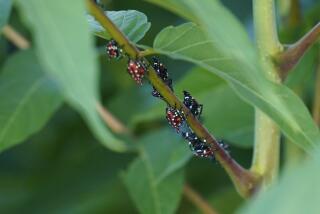Inside Southern California’s biggest pumpkin patch for Halloween: $5 a head
Under the watchful eyes of Chino prison guards, some 40 acres of fat orange gourds were harvested a week ago and trucked 11 miles north to a 5-acre field outside Cal Poly Pomona’s Farm Store, which becomes home to a monthlong Pumpkin Fest leading up to Halloween and what is said to be the single biggest pumpkin patch in Southern California.
The school’s AGRIscapes outreach program brings some serious cred to that claim: Last year it sold 70,000 pumpkins and attracted 120,000 visitors during the month of October, to raise awareness about Cal Poly Pomona’s Don B. Huntley College of Agriculture, one of the state’s top agriculture schools.
For the record:
11:36 a.m. Oct. 3, 2019An earlier version of this story said pumpkin patch visitor Giselle Quiroz was from Glendale. She is from Glendora. The story also has been updated to clarify that Cal Poly Pomona’s Don B. Huntley College of Agriculture’s enrollment this year is 2,200, a record number.
They’re doing it again this year, starting with the 27th Pumpkin Festival kickoff event Saturday and Sunday. Visitors can wander a 3-acre corn maze (or a smaller kid-friendly maze), build a scarecrow, ogle antique tractors and other vintage machines, sample honey fresh off the comb and visit farm animals in a petting zoo. The kickoff weekend also includes a variety of food and agriculture-related crafts vendors, mostly student groups that count the weekend as one of their best fundraising opportunities.
The rest of the month (except for Mondays, when it is closed) belongs to Pumpkin Fest, a less crowded but no less festive version of the seasonal activities. The vendors and special activities will be gone, but you can still wander the corn maze, visit the farm animals and take a hayride, in addition to finding your perfect pumpkin. (Check out specifics on the website.)
No matter when you go, be prepared to do some waiting. The crowds keep growing every year, and it’s equal parts heartening and unbelievable to organizer Craig Walters, director of the AGRIscapes Outreach Center and a 1978 Cal Poly agriculture alumn. Walters didn’t pursue agriculture for his first career; he spent 30 years making documentary films instead. But when the job opened up to promote the college’s agricultural programs through special events and school field trips, his agriculture-theatrical background helped him create some surprisingly crowd-pleasing activities.
“We have a large exhibit of antique engines and nonelectric devices, where people can push a plunger to agitate clothes in an old washer. Last year we had a line of kids standing in line to pump this thing, and it’s the lowest-tech thing you can imagine,” Walters said. “As someone who grew up here, next to orange groves, I find it encouraging that, given a chance, kids love to put their hands in the dirt, or see how things work. They don’t have to have videos or high-tech to get enjoyment.”
The activities all fit into the university’s motto: “Learn by doing,” and the outreach seems to be paying off. The agricultural school’s enrollment of 2,200 students this year is the highest in its 80-year history, Walters said. But the programs aren’t training hands-in-the-dirt farmers so much anymore, he said, as much as students who want to work in some aspect of the agriculture industry, such as selling produce, brewing craft beer, doctoring animals and making clothing and textiles.
There’s still plenty of farming, however, on campus and off, all offering a glimpse into California’s agricultural past and its future.
Students farm 150 acres around the campus, providing sweet corn, melons, tomatoes, peppers and plenty of other produce for the school’s popular Farm Store, a red barn building in the center of the AGRIscapes activities area. It’s open daily, but lucky festival-goers get exclusive access this weekend.
The college also leases another 800 acres around the Chino men’s prison for its farming programs.
Years ago, inmates helped tend those fields, Walters said, but that changed after family housing projects began encroaching on the area and people worried about prisoners getting away. Now students and college-hired staff work in those fields, which are dotted with tall watchtowers. (Prison guards were quick to investigate when I stopped by the side of the road to scout out this story. “You’re on prison property here,” one guard said incredulously. “We get real curious when people start taking photos.”)
The college started growing pumpkins on campus 27 years ago, as part of its student programming and charged a nominal fee to people who wanted to wander in a field to cut their own pumpkins.
But the pumpkin patch got so popular that student clubs asked if they could get involved to raise money for their organizations. The event grew from there, Walters said, but the pumpkin fields were moved to Chino around 2001, so the college could develop its AGRIscapes property, with the Farm Store, visitor center, children’s garden, greenhouses and Discovery Farm, a kind of mini-demonstration farm.
Walters emphasized that the outreach programs are all self-supporting. “We don’t receive a single penny from state funding, not for my salary or student worker salaries,” he said. “It all comes from the activities and events we put on.”
Admission to the kickoff weekend used to be free, but about five years ago, as the crowds got unmanageable, AGRIscapes started charging a small fee, on top of charges for activities. It helped, but the kickoff still attracted 40,000 visitors last year, so be prepared for lines. Admission is $5 for adults and $4 for children 2-12. There’s a $12 family ticket that provides entry for two adults and two children, and you can save a dollar per person by buying tickets online.
Your ticket gets you into the Ag Discovery Lane, where you can explore (and in some cases operate) antique farm tractors and equipment and participate in demonstrations and activities like rubber duck races, cow milking, sheep shearing and beekeeping. You can also try your hand at the pumpkin pie-eating contest, pumpkin seed-spitting contest and kids costume contest. Expect to pay an additional fee to choose a pumpkin ($5), visit the insect fair ($3), take a hayride, visit the petting zoo or wander the 3-acre corn maze ($3).
If want to avoid massive crowds — and an admission fee — come later in the month, when entry is free.
Also, wear good walking shoes.
Cal Poly’s 3-acre corn maze is 12 feet high, and you’ll cover a fair bit of ground trying to get out. For a nongory but still spooky experience, bring a flashlight and try the new Night Maze on Friday and Saturday nights, starting Oct. 11.
Haunted hayrides take place after dark Fridays and Saturdays, accompanied by ghost stories from local lore. Children must be 8 or older to participate in night activities, and those under 12 must be accompanied by an adult. Tickets are $3 for each event.
A much smaller corn maze is available for children only. The corn is still 12 feet tall, but the maze is entirely fenced, so no one can really get lost, and has a much easier route, with a $2 entry fee.
Find out more about the many activities at cpp.edu.
Cal Poly Pomona’s annual pumpkin festivities
When: Pumpkin Festival Weekend is 8 a.m. to 5 p.m. Oct. 5 and 6. Pumpkin Fest runs 10 a.m. to 8 p.m. Oct. 8-31, closed Mondays. Check the field trip schedule online because weekday school trips can lead to closures.
Cost: Admission to the pumpkin patch is free Oct. 8-31. Admission to the Oct. 5-6 festivities are $5 for adults and $4 for children 2-12, with packages and discounts available when you buy tickets online. Additional fees for some activities.
Info: cpp.edu/~pumpkinfestival/
More to Read
Sign up for The Wild
We’ll help you find the best places to hike, bike and run, as well as the perfect silent spots for meditation and yoga.
You may occasionally receive promotional content from the Los Angeles Times.











